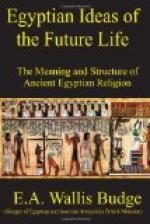When we examine this story by the light of the results of hieroglyphic decipherment, we find that a large portion of it is substantiated by Egyptian texts: e.g., Osiris was the son of Seb and Nut; the Epact is known in the Calendars as “the five additional days of the year”; the five gods, Osiris, Horus, Set, Isis, and Nephthys, were born on the days mentioned by Plutarch; the 17th day of Athyr (Hathor) is marked as triply unlucky in the Calendars; the wanderings and troubles of Isis are described, and “lamentations” which she is supposed to have uttered are found in the texts; lists of the shrines of Osiris are preserved in several inscriptions; the avenging of his father by Horus is referred to frequently in papyri and other documents; the conflict between Set and Horus is described fully in a papyrus in the British Museum (No. 10,184); a hymn in the papyrus of Hunefer relates all that Thoth performed for Osiris; and the begetting of Horus by Osiris after death is mentioned in a hymn to Osiris dating from the XVIIIth dynasty in the following passage:—
“Thy sister put forth her protecting power for thee, she scattered abroad those who were her enemies, she drove away evil hap, she pronounced mighty words of power, she made cunning her tongue, and her words failed not. The glorious Isis was perfect in command and in speech, and she avenged her brother. She sought him without ceasing, she wandered round and round the earth uttering cries of pain, and she rested (or alighted) not until she had found him. She overshadowed him with her feathers, she made air (or wind) with her wings, and she uttered cries at the burial of her brother. She raised up the prostrate form of him whose heart was still, she took from him of his essence, she conceived and brought forth a child, she suckled it in secret, and none knew the place thereof; and the arm of the child hath waxed strong in the great house of Seb. The company of the gods rejoice, and are glad at the coming of Osiris’s son Horus, and firm of heart and triumphant is the son of Isis, the heir of Osiris.” [Footnote: This remarkable hymn was first made known by Chabas, who published a translation of it, with notes, in Revue Archeologique, Paris, 1857, t. xiv. p. 65 ff.]
[Illustration: 1. Isis suckling her child Horus in the papyrus swamps. 2. Thoth giving the emblem of magical protection to Isis. 3. Amen-R[=a] presenting the symbol of “life” to Isis. 4. The goddess Nekhebet presenting years, and life, stability, power, and sovereignty to the son of Osiris. 5. The goddess Sati presenting periods of years, and life, stability, power, and sovereignty to the son of Osiris.]




